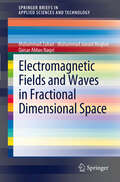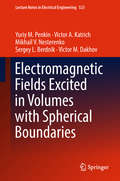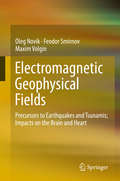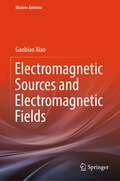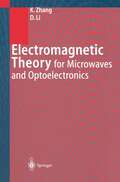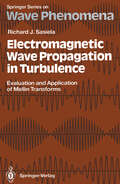- Table View
- List View
Electromagnetic and Quantum Measurements: A Bitemporal Neoclassical Theory
by Tore Wessel-BergIt is a pleasure to write a foreword for Professor Tore Wessel-Berg's book, "Electromagnetic and Quantum Measurements: A Bitemporal Neoclassical Theory." This book appeals to me for several reasons. The most important is that, in this book, Wessel-Berg breaks from the pack. The distinguished astrophysicist Thomas Gold has written about the pressures on scientists to move in tight formation, to avoid having their legs nipped by the sheepdogs of science. This book demonstrates that Wessel-Berg is willing to take that risk. I confess that I do not sufficiently understand this book to be able to either agree or disagree with its thesis. Nevertheless, Wessel-Berg makes very cogent arguments for setting out on his journey. The basic equations of physics are indeed time-reversible. Our experience, that leads us to the concept of an "arrow of time," is derived from macro scopic phenomena, not from fundamental microscopic phenomena. For this reason, it makes very good sense to explore the consequences of treating microscopic phenomena on the assumption that forward time and backward time are equal.
Electromagnetic Fields and Waves in Fractional Dimensional Space (SpringerBriefs in Applied Sciences and Technology)
by Muhammad Zubair Muhammad Junaid Mughal Qaisar Abbas NaqviThis book presents the concept of fractional dimensional space applied to the use of electromagnetic fields and waves. It provides demonstrates the advantages in studying the behavior of electromagnetic fields and waves in fractal media. The book presents novel fractional space generalization of the differential electromagnetic equations is provided as well as a new form of vector differential operators is formulated in fractional space. Using these modified vector differential operators, the classical Maxwell's electromagnetic equations are worked out. The Laplace's, Poisson's and Helmholtz's equations in fractional space are derived by using modified vector differential operators.
Electromagnetic Fields Excited in Volumes with Spherical Boundaries (Lecture Notes in Electrical Engineering #523)
by Yuriy M. Penkin Victor A. Katrich Mikhail V. Nesterenko Sergey L. Berdnik Victor M. DakhovThis book discusses the problem of electromagnetic wave excitation in spatial regions with spherical boundaries and the accurate mathematical modeling based on numerical and analytical methods to significantly reduce the time required for developing new antenna devices. It particularly focuses on elements and systems on mobile objects of complex shape that are made of new technological materials. The experimental development of such devices and systems is an extremely time-consuming, lengthy, and expensive process. The book is intended for senior and postgraduate students and researchers working in the fields of radiophysics, radio engineering and antenna design. The authors assume that readers understand the basics of vector and tensor analysis, as well as the general theory of electrodynamics. The original results presented can be directly used in the development of spherical antennas and antenna systems for the mobile objects. The book addresses problems concerning the construction of Green’s functions for Hertz potentials in electrodynamic volumes with spherical boundaries, and solves these clearly and concisely. It also uses specific examples to analyze areas where the results could potentially be applied. The book covers the following topics: · excitation of electromagnetic fields in coordinate electrodynamic volumes; · Green’s functions for spherical resonators; · Green’s functions for infinite space outside of spherical scatterers; · electromagnetic fields of dipole radiators on spherical scatterers; · electromagnetic fields of thin radial impedance vibrators on perfectly conducting spheres; · electrodynamic characteristics of narrow slots in spherical surfaces; · multi-element and combined vibrator-slot radiators on spherical surfaces.
Electromagnetic Form Factors of Charmed Baryons in Lattice QCD (Springer Theses)
by Kadir Utku CanThis thesis presents the first lattice quantum chromodynamics (QCD) approach to the charmed baryon regime, building on the knowledge and experience gained with former lattice QCD applications to nucleon structure. The thesis provides valuable insights into the dynamics of yet unobserved charmed baryon systems. Most notably, it confirms that the expectations of model or effective field theoretical calculations of heavy-hadron systems hold qualitatively, while also demonstrating that they conflict with the quantitative results, pointing to a tension between these complementary approaches. Further, the book presents a cutting-edge approach to understanding the structure and dynamics of hadrons made of quarks and gluons using QCD, and successfully extends the approach to charmed hadrons. In particular, the thesis investigate a peculiar property of charmed hadrons whose dynamics, i.e., structure, deviates from their counterparts, e.g., those of protons and neutrons, by employing the lattice QCD approach —a state-of-the-art numerical method and the powerful ab initio, non-perturbative method.
Electromagnetic Geophysical Fields: Precursors to Earthquakes and Tsunamis; Impacts on the Brain and Heart
by Oleg Novik Feodor Smirnov Maxim VolginThis book develops the theory of electromagnetic (EM) precursors to seaquakes (i.e. underwater earthquakes) and tsunamis, including the sequential stages of the transformation of a weak seismic mechanical excitation of the sea bottom into EM signals in the atmosphere. It further examines the relationship between geophysics and biophysics, using appropriate mathematical support, and a new model of the magnetic location of the epicenter of a possible land earthquake is described, as well as a block-scheme of the multidisciplinary multilevel seaquake monitoring complex. Also discussed are measured changes of brain bioelectric activity and heart functioning under the influence of moderate geomagnetic storms. Written for researchers and specialists (e.g. upper level undergraduates, postgraduates, scientists) in mathematical, computational, geophysical, biophysical, geodynamical, seismological and prognostic disciplines, this book provides multidisciplinary data and analytical tools supporting the theory and practice of seismic prognosis, promoting further understanding of novel marine and land monitoring systems.
Electromagnetic Linear Machines with Dual Halbach Array: Design and Analysis
by Liang Yan Lu Zhang Juanjuan Peng Lei Zhang Zongxia JiaoThis book extends the conventional two-dimensional (2D) magnet arrangement into 3D pattern for permanent magnet linear machines for the first time, and proposes a novel dual Halbach array. It can not only effectively increase the radial component of magnetic flux density and output force of tubular linear machines, but also significantly reduce the axial flux density, radial force and thus system vibrations and noises. The book is also the first to address the fundamentals and provide a summary of conventional arrays, as well as novel concepts for PM pole design in electric linear machines. It covers theoretical study, numerical simulation, design optimization and experimental works systematically. The design concept and analytical approaches can be implemented to other linear and rotary machines with similar structures. The book will be of interest to academics, researchers, R&D engineers and graduate students in electronic engineering and mechanical engineering who wish to learn the core principles, methods, and applications of linear and rotary machines.
Electromagnetic Modelling and Measurements for Analysis and Synthesis Problems (NATO Science Series E: #199)
by B. De NeumannIn this volume is presented the proceedings of a NATO Advanced Study Institute (ASI) on the theme of Electromagnetic Modelling and Measurements for Analysis and Synthesis Problems. The ASI was held at 11 Ciocco, Castelvecchio Pascoli, Tuscany, Italy, August 10th - 21st, 1987. It has been my good fortune to act as co-director of two of Jozef's previous ASIs, and so I am well acquainted with the JKS format for ASIs. As participants will realise, I did not attend this ASI, and so I only have a partial appreciation of the programme. In particular it has not been possible to include transcripts of any panel discussions which may have taken place. Readers may recall that such transcripts have formed a most interesting and useful part of previous ASI proceedings edited by Jozef Skwirzynski, and helped to convey the spirit of the meetings. Unfortunately it has proved impossible to locate the tapes, despite the best efforts of Jozef's assistant, Barry Stuart. A further dificulty has arisen through the untimely death of Jozef's former deputy and colleague at GEC Research, Ed Pacello, who assisted Jozef with the organisation of the precursor of this ASI. The following is taken from original material relating to the aims of the Advanced Study Institute: "PURPOSE OF THE INSTITUTE This Institute is concerned with computer modelling and with experimental measurements as two complementary tools for both analysis and synthesis of electromagnetics (EM), infra-red (IR) and optical problems.
Electromagnetic Radiation: Including Seminal Papers of Julian Schwinger (Particle Acceleration and Detection)
by Kimball A. Milton Julian SchwingerJulian Schwinger was already the world’s leading nuclear theorist when he joined the Radiation Laboratory at MIT in 1943, at the ripe age of 25. Just 2 years earlier he had joined the faculty at Purdue, after a postdoc with OppenheimerinBerkeley,andgraduatestudyatColumbia. Anearlysemester at Wisconsin had con?rmed his penchant to work at night, so as not to have to interact with Breit and Wigner there. He was to perfect his iconoclastic 1 habits in his more than 2 years at the Rad Lab. Despite its deliberately misleading name, the Rad Lab was not involved in nuclear physics, which was imagined then by the educated public as a esoteric science without possible military application. Rather, the subject at hand was the perfection of radar, the beaming and re?ection of microwaves which had already saved Britain from the German onslaught. Here was a technology which won the war, rather than one that prematurely ended it, at a still incalculable cost. It was partly for that reason that Schwinger joined this e?ort, rather than what might have appeared to be the more natural project for his awesome talents, the development of nuclear weapons at Los Alamos. He had got a bit of a taste of that at the “Metallurgical Laboratory” in Chicago, and did not much like it. Perhaps more important for his decision to go to and stay at MIT during the war was its less regimented and isolated environment.
Electromagnetic Radiation: Variational Methods, Waveguides and Accelerators
by Kimball A. Milton J. SchwingerJulian Schwinger was already the world’s leading nuclear theorist when he joined the Radiation Laboratory at MIT in 1943, at the ripe age of 25. Just 2 years earlier he had joined the faculty at Purdue, after a postdoc with OppenheimerinBerkeley,andgraduatestudyatColumbia. Anearlysemester at Wisconsin had con?rmed his penchant to work at night, so as not to have to interact with Breit and Wigner there. He was to perfect his iconoclastic 1 habits in his more than 2 years at the Rad Lab. Despite its deliberately misleading name, the Rad Lab was not involved in nuclear physics, which was imagined then by the educated public as a esoteric science without possible military application. Rather, the subject at hand was the perfection of radar, the beaming and re?ection of microwaves which had already saved Britain from the German onslaught. Here was a technology which won the war, rather than one that prematurely ended it, at a still incalculable cost. It was partly for that reason that Schwinger joined this e?ort, rather than what might have appeared to be the more natural project for his awesome talents, the development of nuclear weapons at Los Alamos. He had got a bit of a taste of that at the “Metallurgical Laboratory” in Chicago, and did not much like it. Perhaps more important for his decision to go to and stay at MIT during the war was its less regimented and isolated environment.
Electromagnetic Sources and Electromagnetic Fields (Modern Antenna)
by Gaobiao XiaoThis book presents a modified spherical harmonic expansion method in which the electromagnetic fields and their sources are expanded with the same set of spherical vector basis functions in a similar procedure. Explicit expressions for the electromagnetic fields, potentials, energies, and the related Green’s functions are derived for the spherical modes in both frequency domain and time domain. Based on the formulation, the relationships between the electromagnetic sources, the electromagnetic far fields, and the electromagnetic near fields are clearly revealed. In particular, a nonuniform transmission line model is developed for intuitively characterizing the total radiation process. The introduction of the cutoff radius and the cutoff mode degree provides a simple reference for determining the numbers of degrees of freedom of the fields associated with sources in a bounded region. Based on the theory, an efficient hybrid method for synthesizing antenna arrays with complex footprints is proposed and demonstrated with several numerical examples. Effective algorithms are also developed for reconstructing the radiating part of the current sources.This book is intended for researchers, engineers, and graduate students who are interested in studying the energy transfer in electromagnetic radiation, synthesis and measurement of antenna arrays, and applications of inverse electromagnetic source problems.
Electromagnetic Theory for Microwaves and Optoelectronics
by Kequian Zhang Dejie LiThis book is a first-year graduate text on electromagnetic fields and waves. It is the translated and revised edition of the Chinese version with the same title published by the Publishing House of Electronic Industry (PHEI) of China in 1994. The text is based on the graduate course lectures on "Advanced Elec trodynamics" given by the authors at Tsinghua University. More than 300 students from the Department of Electronic Engineering and the Depart ment of Applied Physics have taken this course during the last decade. Their particular fields are microwave and millimeterwave theory and technology, physical electronics, optoelectronics and engineering physics. As the title of the book shows, the texts and examples in the book concentrate mainly on electromagnetic theory related to microwaves and optoelectronics, or light wave technology. However, the book can also be used as an intermediate-level text or reference book on electromagnetic fields and waves for students and scientists engaged in research in neighboring fields.
Electromagnetic Wave Propagation in Turbulence: Evaluation and Application of Mellin Transforms (Springer Series on Wave Phenomena #18)
by Richard J. SasielaElectromagnetic Wave Propagation in Turbulence is devoted to a method for obtaining analytical solutions to problems of electromagnetic wave propagation in turbulence. In a systematic way the monograph presents the Mellin transforms to evaluate analytically integrals that are not in integral tables. Ample examples of application are outlined and solutions for many problems in turbulence theory are given. The method itself relates to asymptotic results that are applicable to a broad class of problems for which many asymptotic methods had to be employed previously.
Electromagnetic Wave Scattering on Nonspherical Particles: Basic Methodology and Simulations (Springer Series in Optical Sciences #145)
by Tom Rother Michael KahnertThis book gives a detailed overview of the theory of electromagnetic wave scattering on single, homogeneous, but nonspherical particles. Beside the systematically developed Green’s function formalism of the first edition this second and enlarged edition contains additional material regarding group theoretical considerations for nonspherical particles with boundary symmetries, an iterative T-matrix scheme for approximate solutions, and two additional but basic applications. Moreover, to demonstrate the advantages of the group theoretical approach and the iterative solution technique, the restriction to axisymmetric scatterers of the first edition was abandoned.
Electromagnetics: Theory, Techniques, and Engineering Paradigms
by Giorgio FranceschettiDuring the last twenty years the lifestyle of a large portion of the inhabitants of our planet has changed dramatically. This would never have been possible without the massive use of electronic and photonic technology, telecommuni cations, and computers. These disciplines are designed to code, transmit, detect, decode, and process signals and related information, and can be broadly addressed as information science and technology. In the sophisticated society in which we live and operate, this science is diffused transversely and plays a major role in almost every human activity. Information science and technology is the basis of a powerful industry that does not suffer the shortcomings of more traditional human enterprises. Information is a renewable source and its control and processing rely on software codes, which are a creation of the mind, and on related hardware, incredibly sophisticated but made out of simple, abundant materials. The rate of change and transformation of this industry is the highest mankind has ever experienced, and it requires not only the replacement of technologies but also a continuous updating of expertise to keep up with the rapid transformation. There is no doubt that this calls for a change in university training, to avoid students graduating at an already obsolete level.
Electromagnetics, Control and Robotics: A Problems & Solutions Approach
by Harish ParthasarathyThis book covers a variety of problems, and offers solutions to some, in:• Statistical state and parameter estimation in nonlinear stochastic dynamical system in both the classical and quantum scenarios.• Propagation of electromagnetic waves in a plasma as described by the Boltzmann Kinetic Transport Equation.• Classical and Quantum General Relativity. It will be of use to Engineering undergraduate students interested in analysing the motion of robots subject to random perturbation, and also to research scientists working in Quantum Filtering.
Electromagnetics, Control and Robotics: A Problems & Solutions Approach
by Harish ParthasarathyThis book covers a variety of problems, and offers solutions to some, in:• Statistical state and parameter estimation in nonlinear stochastic dynamical system in both the classical and quantum scenarios.• Propagation of electromagnetic waves in a plasma as described by the Boltzmann Kinetic Transport Equation.• Classical and Quantum General Relativity. It will be of use to Engineering undergraduate students interested in analysing the motion of robots subject to random perturbation, and also to research scientists working in Quantum Filtering.
Electromagnetism: With Solved Problems (Undergraduate Texts in Physics)
by Hiqmet KamberajAny curriculum involving science and/or engineering will eventually find itself entering the realm of physics. This book seeks to introduce students to a number of the fundamental concepts in physics and illustrate how different theories were developed out of physical observations and phenomena. The book presents multi-chapter sections on electrostatics, magnetism and electromagnetic waves, with eyes on both the past and the future, touching, along the way, on Coulomb, Gauss, Maxwell, Ohm, Biot-Savart, Ampere, Faraday, Fresnel and Lorentz. The book also contains an appendix that provides the reader with a portion of the mathematical background of vector analysis and vector differential operators. The book approaches its topics through a focus on examples and problem-solving techniques, illustrating vividly how physical theories are applied to problems in engineering and science. The book is primarily aimed at undergraduate students in these two fields, but it also features chapters that are geared towards senior undergraduates working on their final year theses.
Electron-Beam Interactions with Solids: Application of the Monte Carlo Method to Electron Scattering Problems (Springer Tracts in Modern Physics #186)
by Maurizio DaporThe interaction of an electron beam with a solid target has been studied since the early part of the past century. Since 1960, the electron–solid interaction hasbecomethesubjectofanumberofinvestigators’workowingtoitsfun- mental role in scanning electron microscopy, in electron-probe microanalysis, in Auger electron spectroscopy, in electron-beam lithography and in radiation damage. The interaction of an electron beam with a solid target has often been investigated theoretically by using the Monte Carlo method, a nume- cal procedure involving random numbers that is able to solve mathematical problems. This method is very useful for the study of electron penetration in matter. The probabilistic laws of the interaction of an individual electron with the atoms constituting the target are well known. Consequently, it is possible to compute the macroscopic characteristics of interaction processes by simulating a large number of real trajectories, and then averaging them. The aim of this book is to study the probabilistic laws of the interaction of individual electrons with atoms (elastic and inelastic cross-sections); to - vestigate selected aspects of electron interaction with matter (backscattering coe?cients for bulk targets, absorption, backscattering and transmission for both supported and unsupported thin ?lms, implantation pro?les, seconda- electron emission, and so on); and to introduce the Monte Carlo method and its applications to compute the macroscopic characteristics of the inter- tion processes mentioned above. The book compares theory, computational simulations and experimental data in order to o?er a more global vision.
Electron Correlations and Materials Properties
by A. Gonis Nicholis Kioussis Mikael CiftanThis volume, the proceedings of a 1998 international workshop, provides experimental evidence of the effects of correlation on the physical, chemical, and mechanical properties of materials, as well as the theoretical/computational methodology that has been developed for their study.
Electron Correlations in Molecules and Solids (Springer Series in Solid-State Sciences #100)
by Peter FuldeThis volume bridges the gap between quantum chemistry and solid-state theory. The text develops new concepts for treating many-body and correlation effects, and deals with applications of the theory to molecules, semiconductors, transition metals, heavy-fermion systems, and the new high-Tc superconducting materials.
Electron Correlations in Molecules and Solids (Springer Series in Solid-State Sciences #100)
by Peter FuldeDieser Titel verbindet die Festkörpertheorie mit der Quantenchemie. Neue Konzepte der Vielteilchen-Verarbeitung und Korrelations-Effekte, normale quantenchemische Verfahren mit Projektionstechniken, Greensche Funktionen und Monte-Carlo-Methoden werden erarbeitet. Anwendungsbereiche der Molekültheorie, von Halbleitern, supraleitender high-Tc-Materialien, etc., werden vorgestellt.
Electron Energy Loss Spectrometers: The Technology of High Performance (Springer Series in Optical Sciences #63)
by Harald IbachElectron energy loss spectroscopy has become an indispensable tool in surface analysis. Although the basic physics of this technique is well understood, instrument design has previously largely been left to intuition. This book is the first to provide a comprehensive treatment of the electron optics involved in the production of intense monochromatic beams and the detection of scattered electrons. It includes a full three-dimensional analysis of the electron optical properties of electron emission systems, monochromators and lens systems, placing particular emphasis on the procedures for matching the various components. The description is kept mathematically simple and focuses on practical aspects, with many hints for writing computer codes to calculate and optimize electrostatic lens elements.
Electron Localization-Delocalization Matrices (Lecture Notes in Chemistry #112)
by Chérif F. Matta Ronald Cook Paul W. AyersThis book builds bridges between two yet separated branches of theoretical and mathematical chemistry: Chemical Graph Theory and Electronic Structure Calculations. Although either of the fields have developed their own techniques, problems, methods, and favorite benchmark cases independent from each other, the authors have managed to bring them together by using the localization-delocalization matrix (LDM). The LDM is a novel molecular descriptor that fingerprints a molecule by condensing the complicated electronic information in one, mathematically manageable, object. In this book, the authors introduce the readers to modeling techniques based on LDMs. Their technique offers a high accuracy as well as robust predictive power, often dramatically surpassing the potential of either of the constituting methods on their own. In addition to the comprehensive and accessible introduction to this new field of theoretical chemistry, the authors offer their self-developed software free to download, so that readers can try running their own simulations. The described methods are very general and can easily be implemented for calculating various properties and parameters such as mosquito repelling activity, ionic liquid properties, local aromaticity of ring molecules, log P's, pKa's, LD50, corrosion inhibition activities, and Lewis acidities and basicities – to only name a few. The free downloadable software helps readers automate the analysis of the matrices described in this book and hence facilitates application of the described methodology.
The Electron Mass and Calcium Isotope Shifts: High-Precision Measurements of Bound-Electron g-Factors of Highly Charged Ions (Springer Theses)
by Florian Köhler-LangesThis thesis presents the first isotope-shift measurement of bound-electron g-factors of highly charged ions and determines the most precise value of the electron mass in atomic mass units, which exceeds the value in the literature by a factor of 13. As the lightest fundamental massive particle, the electron is one of nature’s few central building blocks. A precise knowledge of its intrinsic properties, such as its mass, is mandatory for the most accurate tests in physics - the Quantum Electrodynamics tests that describe one of the four established fundamental interactions in the universe. The underlying measurement principle combines a high-precision measurement of the Larmor-to-cyclotron frequency ratio on a single hydrogen-like carbon ion studied in a Penning trap with very accurate calculations of the so-called bound-electron g-factor. For the isotope-shift measurement, the bound-electron g-factors of two lithium-like calcium isotopes have been measured with relative uncertainties of a few 10^{-10}, constituting an as yet unrivaled level of precision for lithium-like ions.

